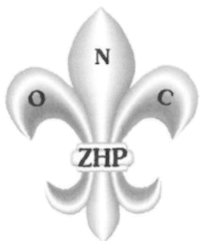
Kielce is a city in south-central Poland and the capital of the Świętokrzyskie Voivodeship. In 2021, it had 192,468 inhabitants. The city is in the middle of the Świętokrzyskie Mountains, on the banks of the Silnica River, in the northern part of the historical Polish province of Lesser Poland.

The Polish Scouting and Guiding Association is the coeducational Polish Scouting organization recognized by the World Organization of the Scout Movement and the World Association of Girl Guides and Girl Scouts. It was founded in 1918 and currently is the largest Scouting organization in Poland. The first ZHP was founded in 1916, the current one is the fourth organization with this name. It is a public benefit organization as defined by Polish law.

"Grey Ranks" was a codename for the underground paramilitary Polish Scouting Association during World War II.

Jerzy Nowosielski was a Polish painter, graphic artist, scenographer, illustrator and Eastern Orthodox theologian. He is regarded among the greatest contemporary Polish icon painters.

Jarosław Kukowski is a Polish contemporary painter, juror of international art competitions. His works were exhibited, among others Branch Museum of the National-Królikarnia Salons Rempex Auction House, the Museum of Galicia, the Contemporary Art Gallery, Castle Voergaard, the Art Expo New York and many other galleries and museums in the world. He is considered one of the most influential contemporary creators of the Surrealist circle.

Aleksander Kamiński, assumed name: Aleksander Kędzierski. Also known under aliases such as Dąbrowski, J. Dąbrowski, Fabrykant, Faktor, Juliusz Górecki, Hubert, Kamyk, Kaźmierczak, Bambaju was an educator, co-founder of Cub Scouts methodology, and soldier of the Home Army. He was one of the ideological leaders of the Grey Ranks and chairman of the Presidium of the Supreme Council of the Polish Scouting Association.
Anna Zawadzka was a Polish teacher, author of textbooks, Scoutmaster (harcmistrzyni), sister of Tadeusz "Zośka" Zawadzki and daughter of professor and chemist Józef Zawadzki.

The Warsaw National Museum, also known as the National Museum in Warsaw, is a national museum in Warsaw, one of the largest museums in Poland and the largest in the capital. It comprises a rich collection of ancient art, counting about 11,000 pieces, an extensive gallery of Polish painting since the 16th century and a collection of foreign painting including some paintings from Adolf Hitler's private collection, ceded to the museum by the American authorities in post-war Germany. The museum is also home to numismatic collections, a gallery of applied arts and a department of oriental art, with the largest collection of Chinese art in Poland, comprising some 5,000 objects.

The Scouting and Guiding movement in Poland consists of about twelve independent organizations with an overall membership of about 160,000 Scouts and Guides. The largest organization by membership is Polish Scouting and Guiding Association with about 140,000 members.

POLIN Museum of the History of Polish Jews is a museum on the site of the former Warsaw Ghetto. The Hebrew word Polin in the museum's English name means either "Poland" or "rest here" and relates to a legend about the arrival of the first Jews to Poland. Construction of the museum in designated land in Muranów, Warsaw's prewar Jewish quarter, began in 2009, following an international architectural competition won by Finnish architects Rainer Mahlamäki and Ilmari Lahdelma.

The National Museum in Poznań, Poland, abbreviated MNP, is a state-owned cultural institution and one of the largest museums in Poland. It houses a rich collection of Polish painting from the 16th century on, and a collection of foreign painting. The museum is also home to numismatic collections and a gallery of applied arts.

The Geological Museum of the State Geological Institute is a museum in Warsaw, Poland. The museum was established in 1919.

The Museum of Polish History or the Polish History Museum is a museum and national cultural institute in Warsaw, Poland. The purpose of the museum is to present the most important events in Polish history, with a particular emphasis on Polish traditions of freedom. Since September 2023, the new museum building has been located in the Warsaw Citadel.

The Fryderyk Chopin Museum is a museum in Warsaw, Poland, established in 1954 and dedicated to Polish composer Frédéric Chopin. Since 2005, the museum has been operated by the Fryderyk Chopin Institute.

Museum of Science and Industry in Kraków was a museum in Kraków, Poland. It was established in 1868, at the initiative of Adrian Baraniecki, a Polish physician and social activist.
Józef Kachel was a Polish Boy Scouts Scoutmaster in Germany, a member of the Polish United Workers' Party (PZPR), and a Member of the Polish Parliament

Stefan Adam Garwatowski or Gerwatowski was a Polish painter. He was an alumnus of Academy of Fine Arts in Warsaw (1956).
Ryszard Wcisło "Chytry Jastrząb" was a Polish scout leader who worked in the Kraków branch of Polish Scouting and Guiding Association, KIHAM, ZHP-1918, and lately in Scouting Association of the Republic.

The Michniów massacre is a massacre that occurred on 12–13 July 1943 in the village of Michniów during German occupation of Poland when approximately 204 of its inhabitants, including women and children, were massacred by German Ordnungspolizei and Schutzstaffel.

The Mausoleum of the Martyrdom of Polish Villages in Michniów is a museum located in Michniów, in Świętokrzyskie Voivodeship, in Poland, constituting a branch of the Museum of the Kielce Village, commemorating the pacification actions in German-occupied Poland.





















